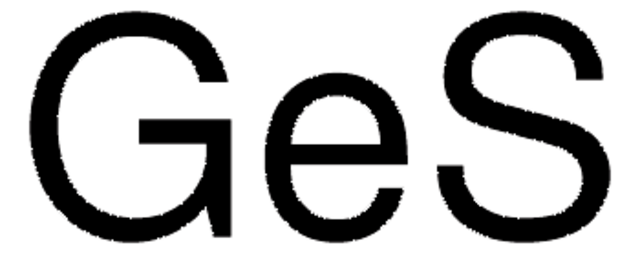全部照片(3)
選擇尺寸
變更視圖
5 G
50 G
About This Item
線性公式:
Sb2S3
CAS號碼:
分子量::
339.72
EC號碼:
MDL號碼:
分類程式碼代碼:
12352300
PubChem物質ID:
NACRES:
NA.23
推薦產品
品質等級
化驗
99.995% trace metals basis
mp
550 °C (lit.)
密度
4.64 g/mL at 25 °C (lit.)
SMILES 字串
S=[Sb]S[Sb]=S
InChI
1S/3S.2Sb
InChI 密鑰
IHBMMJGTJFPEQY-UHFFFAOYSA-N
尋找類似的產品? 前往 產品比較指南
一般說明
Antimony(III) sulfide (Sb2S3) is a semiconductor material known for its unique optical and electronic properties, including a direct bandgap of approximately 1.7 eV, making it suitable for photovoltaic applications. Its high absorption coefficient enables effective light harvesting, which is advantageous in solar cells and photodetectors. Additionally, Sb2S3 exhibits promising thermoelectric properties, making it a candidate for energy conversion applications.
應用
- Thermal decomposition of tris(O-ethyldithiocarbonato)-antimony(III): A single-source precursor for antimony sulfide thin films, important for developing materials with specific optical properties (Eensalu et al., 2022).
- Antimony sulfide as a light absorber in highly ordered, coaxial nanocylindrical arrays: Discusses the integration of antimony sulfide into photovoltaic devices, significant for chemists interested in renewable energy solutions (Wu et al., 2015).
- Syntheses and characterization of one-dimensional alkali metal antimony (III) thiostannates: Explores novel antimony(III) sulfide compounds for potential use in electronic and photonic devices (Yohannan and Vidyasagar, 2015).
- Antimony (III) speciation in hydrosulfide solutions: Provides insights into the geochemical behavior of antimony sulfide complexes, important for environmental chemists and academia studying heavy metal cycling (Olsen et al., 2019).
訊號詞
Warning
危險聲明
危險分類
Aquatic Chronic 3 - Carc. 2 - STOT RE 2
標靶器官
Lungs
儲存類別代碼
6.1C - Combustible acute toxic Cat.3 / toxic compounds or compounds which causing chronic effects
水污染物質分類(WGK)
WGK 2
閃點(°F)
Not applicable
閃點(°C)
Not applicable
個人防護裝備
dust mask type N95 (US), Eyeshields, Gloves
客戶也查看了
Choong-Sun Lim et al.
Physical chemistry chemical physics : PCCP, 14(10), 3622-3626 (2012-02-09)
Performance of Sb(2)S(3)-sensitized heterojunction solar cells is enhanced by embedding Au nanoparticles in the poly-3-hexylthiophene (P3HT) hole-conducting polymer layer. The improved charge transfer/transport at the Sb(2)S(3)/P3HT/Au interface by extended interface area of the P3HT/Au counter electrode and the re-absorption of
Chris Tsopelas
Applied radiation and isotopes : including data, instrumentation and methods for use in agriculture, industry and medicine, 59(5-6), 321-328 (2003-11-19)
The chemistry of antimony trisulphide colloid (ATC) was examined to elucidate the radiolabelling mechanism with 99mTcO4(-). Ion exchange chromatography and atomic absorption spectrophotometry techniques determined ATC to be resistant to hydrolysis in 0.1M hydrochloric acid (HCl) at 25 degrees C
B Kalin
Acta radiologica. Supplementum, 385, 1-24 (1993-01-01)
Today bone marrow scintigraphy is performed by imaging either the reticuloendothelial system by means of colloids or the hematopoietic marrow with granulocytes. When visualizing the marrow with radiolabeled colloids most of the administered activity will be taken up by the
C Tsopelas
Journal of nuclear medicine : official publication, Society of Nuclear Medicine, 42(3), 460-466 (2001-05-05)
Colloidal particle size is an important characteristic to consider when choosing a radiopharmaceutical for mapping sentinel nodes in lymphoscintigraphy. Photon correlation spectroscopy (PCS) and transmission electron microscopy (TEM) were used to determine the particle size of antimony trisulfide and rhenium
Justin Varghese et al.
Nano letters, 12(2), 868-872 (2012-01-25)
We report the first observation of piezoelectricity and ferroelectricity in individual Sb(2)S(3) nanowires embedded in anodic alumina templates. Switching spectroscopy-piezoresponse force microscopy (SS-PFM) measurements demonstrate that individual, c-axis-oriented Sb(2)S(3) nanowires exhibit ferroelectric as well as piezoelectric switching behavior. Sb(2)S(3) nanowires
Active Filters
我們的科學家團隊在所有研究領域都有豐富的經驗,包括生命科學、材料科學、化學合成、色譜、分析等.
聯絡技術服務














